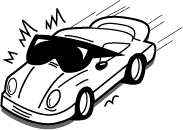About Laser Detector Range
Windshields are like putting sunglasses on your laser detector. And some windshields are darker than others.

TO A LASER DETECTOR, laser looks like a faint light. Spotting a faint light in bright daylight is hard to do; as a result, laser detectors provide less protection on sunny days. But on overcast days, detectors do much better, and V1 works very well at night.
The windshield changes a laser detector’s vision exactly as sunglasses change yours. The view is so bright on a sunny day that sunglasses don’t hurt. But your detector doesn’t want sunglasses any time you wouldn’t wear them. That means that darker windshields hurt laser-detector performance on gray days and at night.
TEST CONCLUSIONS:
- 1: All windshields provide significant losses in laser detection.
- 2: The least-harmful windshields still cut laser-detector range by 60 percent; the worst ones cut up to 80 percent.
- 3: Avoid putting your detector behind the tint band at the top, unless you’re sure it has no effect. We found major losses due to the tint on some cars, and no additional losses on others.
- 4: Road splash on your windshield hurts laser detection, but the splash sample we tested–it was so bad a driver would stop to wash the glass–hurt laser detection less than some tint bands.
- 5: Recent model years suggest a trend; that car makers are moving toward glass formulations which cause greater laser losses.
LOOKING ON THE BRIGHTER SIDE, while the windshield reduces the laser signal somewhat, it reduces competition from sunlight by the same amount. So the result is an unchanged laser-to-sunlight ratio, which is the key to daytime laser detection. Because this ratio becomes extremely favorable at night, losses through the windshield are more easily tolerated. My best advice: keep the glass clean and be careful of tint bands.
DO-IT-YOURSELF WINDOW TINTING FILMS: Because aftermarket tints have become common customizing tricks, we also tried four samples that we found at either AutoZone or Walmart. These we tested on clear window glass. Clear glass cuts laser range by about 25 percent, and all of the samples cut laser range by an additional 25-35 percent. Metallized films had about the same effect as ordinary tint films.
You might add a tint strip across the top of your windshield to cut glare. If so, a laser detector will suffer a serious loss of performance when placed behind the tint.
REAR-LASER DETECTION would be hurt by tint films on rear and side windows, at least in theory. V1’s rear-laser performance is by far the best in the industry, but don’t expect too much from it. When you’re shot in the back, you’re moving away, so the shooter’s best shot is his first one. If he fails to get a reading on his first shot, you’re so lucky you don’t need a laser detector.
